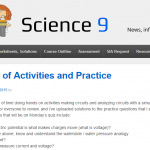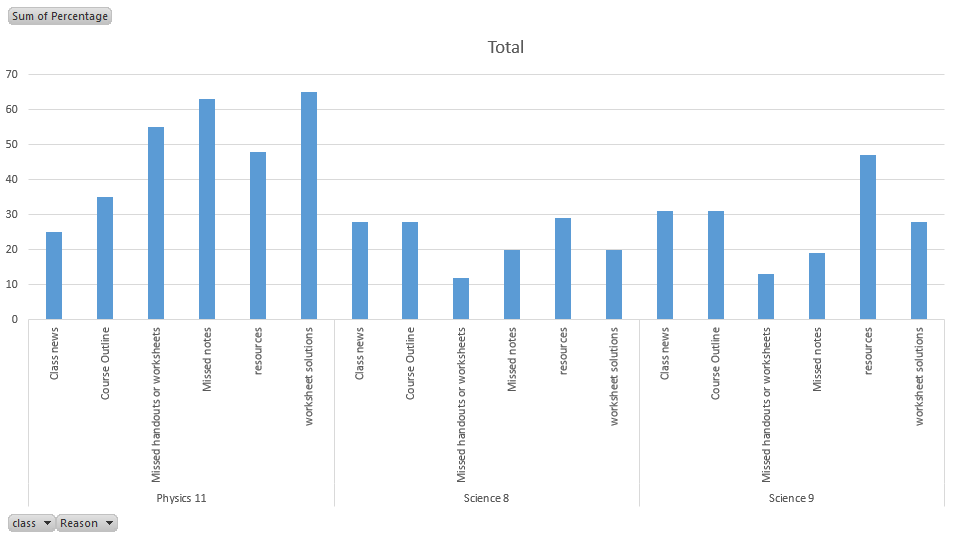Classroom Websites
Over the past 4 years I’ve used several different platforms for classroom websites including wikispaces, wordpress and moodle. They each have strengths and weaknesses, and they all have one thing in common: it takes a lot of work to keep them updated throughout the year. By the end of this year I was taxed out and unsure if I was willing to continue with class websites, the reason being that I wasn’t convinced that my students really used them very much. I often say that if something I do helps even a couple of students, it’s worth doing. In reality, this mantra needs to be balanced with the time needed for my other responsibilities.
For this post I’m going to first summarize how I use these sites and then post some information that I found about how my students use my sites.
Wikispaces
 I’ve used wikispaces for class projects, it works very well for recording and showcasing collaborative projects. One year I used it as a file repository and update of class activities. It worked okay. It was nice to have student work and classroom information on the same site. File handing was awkward though, and there are file size limits. For these reasons I decided to move a blogging platform.
I’ve used wikispaces for class projects, it works very well for recording and showcasing collaborative projects. One year I used it as a file repository and update of class activities. It worked okay. It was nice to have student work and classroom information on the same site. File handing was awkward though, and there are file size limits. For these reasons I decided to move a blogging platform.
Wordpress
 Wordpress was a natural fit for me because I’ve been running my own self-hosted wp blogs for years. It allows me to have complete control over the content and website. Wordpress works well because its blogging system fits very well with class news and updates. The downside is that I needed to upload and host my files somewhere in the cloud (I use box.com), and then link to them in Wordpress. Technically it’s easy but overall it’s extra work and time consuming.
Wordpress was a natural fit for me because I’ve been running my own self-hosted wp blogs for years. It allows me to have complete control over the content and website. Wordpress works well because its blogging system fits very well with class news and updates. The downside is that I needed to upload and host my files somewhere in the cloud (I use box.com), and then link to them in Wordpress. Technically it’s easy but overall it’s extra work and time consuming.
Moodle
 I’ve used Moodle twice in the past few years. When I taught a small Science and Technology 11 class, I was able to get desktop computers in the classroom and have students work in a blended learning environment though an online ScT11 course. It worked fantastic in that context. I’ve also used Moodle for Physics 11. In physics, the moodle site was primarily used as a repository and also for offering auto-marked practice quizzes. Moodle was also used to track “reading quizzes.” I used reading quizzes to test whether or not students did assigned readings. Moodle is good in that it has a full suite of LMS capabilities and I didn’t have limits on the number of files I could upload. The downside is that the Moodle interface is slow (PHP script creating pages on the fly), and student logins creates a roadblock for student access.
I’ve used Moodle twice in the past few years. When I taught a small Science and Technology 11 class, I was able to get desktop computers in the classroom and have students work in a blended learning environment though an online ScT11 course. It worked fantastic in that context. I’ve also used Moodle for Physics 11. In physics, the moodle site was primarily used as a repository and also for offering auto-marked practice quizzes. Moodle was also used to track “reading quizzes.” I used reading quizzes to test whether or not students did assigned readings. Moodle is good in that it has a full suite of LMS capabilities and I didn’t have limits on the number of files I could upload. The downside is that the Moodle interface is slow (PHP script creating pages on the fly), and student logins creates a roadblock for student access.
Student Feedback
At the end of the year I created an online survey for all my students to fill out. I wanted to try and find out how many students found the class websites useful, and what did they actually use it for. Before I discuss the results I should note that I had only a 50% response rate for the survey. The results could be biased towards students that tend to use the class websites.
In terms of use, my Grade 8 students hardly used their website at all. The grade 9’s used it a bit more, and the physics 11 students overall got some decent use out of their website. However, even with the Physics 11 students only 22 students reported using the site more than a few times a month
When I looked at how the students used their website, it becomes clear that the junior science students don’t access uploaded files very much. They’re typically looking for general course information and online resources. The Physics 11 students are interested with most aspects of their website.
In general, the Physics 11 students are using the site for extra information or things that weren’t covered in class. They don’t use the site to find work that they missed. This frustrates me a lot because this should be very useful. Most times when a student misses a class or two, upon their return they asked me what they missed instead of referring to the moodle site. They give up on their opportunity to come to class prepared.
When asked about what device they used to access their sites, most of the Physics 11 students said they used computers at home. I was a bit disappointed to see that the grade 9 students reported using phones and tablets more. Students are more likely to miss out on resources and materials if they only use a phone. Things like flash and java simulations don’t run on phones, and I would often hear that students had trouble opening pdf files on their phones.
Finally, I wanted to get the students’ overall impression of their class websites by rating how useful they found it on a scale of 1 to 5. The grade 8 and 9 students found their website only modestly useful (3 out 5), whereas the Physics 11 students overwhelmingly found their site modestly to very useful.
I also collected comments from students about what they liked and disliked about their class website. The Physics 11 students overall liked that all of the resources are on one site. There were very few things they disliked, the most common one being that they had to log in.
Final Thoughts
I think it’s pretty clear that I should continue to maintain a class website for my physics 11 students. For my junior science classes, I’m really not sure. Overall students don’t use the science 8 and 9 sites very often. I could tell throughout the year that this was the case. For the grade 9 students, to be honest, they really don’t care that much about school. That’s a story for another post, but it’s where things are at. If a teacher were to spend time on anything in particular for grade 9’s it should be on re-engagement. For grade 8 students, they seem to lack the sophistication and organizational ability to take advantage of a class website. Despite the myth of the “digital native” and how adults perceive kids as being excellent with technology, this isn’t really the case. My grade 8 students this year struggled more than ever with simple web activities such as signing up for web accounts and accessing information. My guess is that they are primarily brought up on mobile devices and the idea of one (hidden) single sign-on.
Will I use a class website for grade 8 and 9 students next year? I’m not sure yet. I’m working on developing a journaling system for my junior grades, and this will probably involve a recurring internet activity outside of class. I think this type of activity can really help students develop an educational relationship with computers and the internet, which would be of great benefit to them. More on that idea later.
As always, I look forward to any comments or ideas from you.





